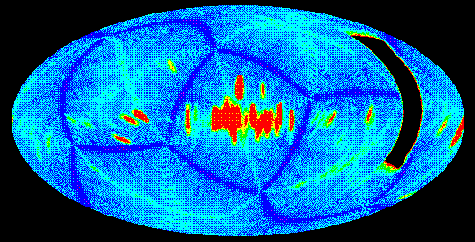Profile: Dr. Padi Boyd
From Singing to Science

Biography
Patricia (Padi) Boyd was born in Perth Amboy, New Jersey. In school, she was very interested in writing, art, ballet and dance, gymnastics and music. "I really didn't spend much time thinking about science when I was a kid, except for when I would ask my Dad to take the telescope out of the basement and look at the Moon."
During the last years of high school, she began to like astronomy more and more. She was drawn to the spectacular images of galaxies and planets, and became absorbed in Carl Sagan's PBS series Cosmos. "I watched every one of the episodes several times, and got the companion book that went along with it. I read it very carefully, and started to look for other books about astronomy. I began to realize that it was possible to study astronomy in college, and started looking for colleges with a good astronomy department." She attended Villanova University, in Pennsylvania. Villanova has three observatories where undergraduates can learn about observing with a telescope and collecting research-quality astronomical data.
Padi studied physics in graduate school at Drexel University, becoming interested in computer modeling of stellar and galactic dynamics. After receiving her Ph.D., she came to Goddard Space Flight Center where she got to combine computational physics and data analysis through working with the Hubble Space Telescope's High Speed Photometer Team. Later, she came to work in the X-ray Astronomy group to work on MOXE, an experiment expected to fly on the Russian Spectrum X-Gamma satellite. She now works as a USRA contractor for the Rossi X-ray Timing Explorer mission.
» What does a USRA contractor do at NASA's Goddard Space Flight Center?
Padi's Research Interests
Padi's main interest is analyzing data from astronomical objects to search for periodic and non-periodic variations, to learn about the dynamical interactions taking place in the objects.
Most of Padi's recent research has involved pulsars in the UV. She has been trying to answer the questions: Do the atmospheres of companion stars reprocess pulsed radiation from the pulsar? (If so, we could analyze the pulse arrival times in the same way we analyze double lined spectroscopic binary systems, and get better mass estimates for the pulsar.) What information can we get about the pulsation mechanism by observing in the UV? Does the standard model of pulsar emission match the observations in the UV? "I find it very challenging and exciting that astronomers can get so much information about the objects they study just by measuring and analyzing the light that the sources emit in our direction."
Tell me more about Padi's research interests!
Other Interests
Padi loves to sing, and is in an a cappella group called the Chromatics. She is also part of a project called AstroCappella, which is an a capella group that performs songs about astronomy. The songs are part of an education outreach effort to teach students about astronomy using music. She likes to vacation at the beach. Her last trip was to St. Thomas in the Virgin Islands with her husband Jim, where they snorkeled and sailed the Caribbean.
Questions and Answers
Q: You decided quite late to pursue science as a career instead of acting or singing. Was this a difficult transition?
A: Yes, it was a difficult transition. I really fell in love with astronomy at that point, and it was the only time I had any real idea of what I wanted to do. Before that it was more like, what should I choose to do, or what am I able to do. I remember that in high school you were always asked what you wanted to study in college and "before astronomy" I really had no idea. Once my mind was made up, my friends were very surprised. They couldn't believe I was serious. I had to take physics the summer after I graduated High School because I had never had it in school. I had a very weak math and science background in general. That really held me back my first year or two of college, when I was being introduced to concepts that my classmates had already seen before. So, in those ways the transition was difficult. But it was easy in other ways. It was and is a great feeling to be doing something so interesting!
Q: If you could invite any three people from throughout history to your house for dinner, who would they be and why would you choose them?
A: I would like to have people whose ideas profoundly impacted the course of history. Martin Luther King, who was able to speak passionately about civil rights in a way that convinced many people that the movement was the right and just thing to do. Cecilia Payne-Gaposchkin, who realized that spectral line strength in stars was an indicator of their temperature more than their chemical composition. This really moved the understanding of stars forward a giant leap. Lao Tsu, whose carefully worded and poetic writings on the way to live a life in balance continue to guide individuals from all over the world.
Q: Who was your favorite teacher in school?
A: My favorite teacher was my history teacher in High School, Mrs. Zelley. She was very smart and interesting and very calm, and she had wanted to be an astronomer when she was younger! She encouraged me to stick with it.
Q: Tell us about your family.
A: I'm married to Jim, a mathematical physicist, and we are expecting our first child in a couple of months. My brothers and sisters and parents all live in different states. We have three cats at home each with a very different personality. One cat meows at imaginary things in the house, one thinks he's still a kitten, and one thinks she is the wise ruler of the house.
Publication Date: April, 1997




